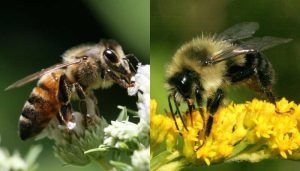Do common methods for protecting bees from pesticides actually work?
by Entomological Society of America

Responsible use of pesticides includes striving to avoid negative effects on the environment, often with an emphasis on protecting bees and other pollinators. A new study, however, finds that many common methods for minimizing pesticides’ impact on bees—even some recommendations on product labels—are backed by minimal scientific evidence. The researchers behind the study, published in the Journal of Economic Entomology, say stronger testing is needed to evaluate which bee-protection measures are truly effective and which ones may be too reliant on conventional wisdom. Moreover, nearly all of the research that has been conducted on these measures has focused on managed honey bees (left) while ignoring wild, native bees such as bumble bees (right) and other pollinators. Credit: (Honey bee photo by Chris Evans, University of Illinois; bumble bee photo by David Cappaert. Both photos via Bugwood.org)
Responsible use of pesticides includes striving to avoid negative effects on the environment, often with an emphasis on protecting bees and other pollinators. A new study, however, finds that many common methods for minimizing pesticides’ impact on bees—even some recommendations on product labels—are backed by minimal scientific evidence.
The researchers behind the study say stronger testing is needed to evaluate which bee-protection measures are truly effective and which ones may be too reliant on conventional wisdom. They share their analysis in a report published in the Journal of Economic Entomology.
Growers are urged to follow a variety of “mitigation measures” meant to protect bees during pesticide applications, such as spraying at night, using specific nozzles on sprayers, or maintaining buffer zones.
“It takes time, money, and effort to follow these rules, so if they are not actually helpful, they are a waste of time,” says Edward Straw, Ph.D., a postdoctoral researcher in the School of Agriculture and Food Science at University College Dublin (UCD) in Ireland and lead author on the study. “If they are helpful, though, they could be applied more widely, to protect bees further.”
Straw and colleague Dara Stanley, Ph.D., assistant professor in applied entomology at UCD, combed published, peer-reviewed research for studies that evaluated the effectiveness of any kind of mitigation measure in reducing a pesticide’s impact on bees. Just 34 studies matched their criteria, spread across a wide range of measures—but largely focused on just one kind of bee.
“Almost all research was centered around protecting honey bees. However, honey bees are a managed species that is not endangered,” Straw says. “When we try to protect bees, we really want to be protecting wild, unmanaged bee species, as these are the species which are in decline.”
Few mitigation measures had more than one or two studies evaluating their effectiveness, and methods of testing varied. For instance, some studies tested for direct overspray while others tested for longer-term pesticide residues. And just three studies among Straw and Stanley’s review evaluated measures frequently found on pesticide labels.
“Least researched was testing on how you time a pesticide spray, be that time of day or time of year,” Straw says. “There’s good reason to believe that if you change when you spray, you could avoid peaks in bee activity. Yet surprisingly no one has really researched if this idea works. This is odd, as it’s a very common mitigation measure and not overly hard to test.”
Other mitigation measures tested in existing studies included how pesticides are applied (e.g., spray parameters or planting methods for pesticide-coated seeds), buffer zones, removing flowering weeds before spraying, direct interventions for managed bees (e.g., moving or covering colonies), and applying pesticides only in certain weather conditions or during certain crop stages.
A newer method had the most studies (12) investigating its potential: repellent additives to pesticide sprays, which encourage bees to avoid a recently sprayed crop. Several compounds have shown promise in lab testing, but all 12 studies tested repellency for honey bees only, and none were tested in formulation with a pesticide—only on their own.
“It is an interesting idea, but it is not yet ready to be used,” says Straw. “It would need to be tested on a diversity of bee and insect species, as if it is only repellent to one or two species, all the other bees would still be exposed to the pesticide.”
In sum, Straw and Stanley say too much hinges on bee-protective measures for them to be weakly supported. Bees play a critical role in both natural ecosystems and agriculture, and the presumption that mitigation measures are effective can be factored into decisions to authorize pesticides for use. Rigorous scientific evaluation of these measures is imperative, they say.
“The main limitation is that these studies need to be big, well-funded pieces of research. To test changes to how a pesticide is applied to a crop, you need to have a crop, a pesticide sprayer, and someone licensed to spray. All of that is expensive and time consuming, making it out of reach for most scientists,” says Straw.
But, if such research can be generated, there’s reason to believe it will have immediate positive impacts. In related research Straw and Stanely published earlier this year, compliance with pesticide regulations and guidelines among farmers in an anonymous survey was high. “We know that these mitigation measures are being followed,” says Straw. “We just do not know if they are helpful yet.”
More information: Edward Straw et al, Weak evidence base for bee protective pesticide mitigation measures, Journal of Economic Entomology (2023). DOI: 10.1093/jee/toad118
Journal information: Journal of Economic Entomology
Provided by Entomological Society of America
We are here to share current happenings in the bee industry. Bee Culture gathers and shares articles published by outside sources. For more information about this specific article, please visit the original publish source: DOI: 10.1093/jee/toad118








